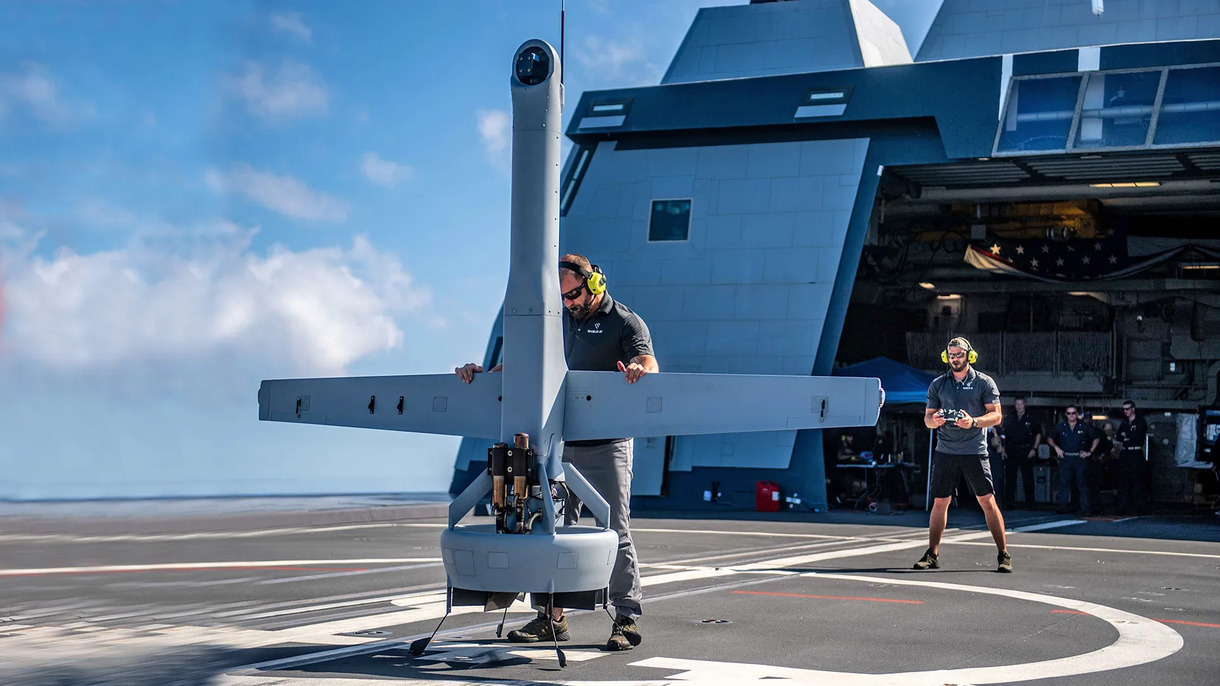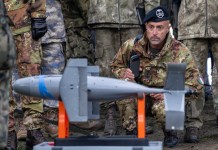AI-powered machine vision in drones is rapidly evolving from a simple target recognition capability to an autonomous navigation, find, and strike capability.
Artemis-10: AI-Driven FPV Warfare
During the Dronnitsa-2025 forum for combat UAV operators held in Veliky Novgorod on October 6–7, 2025, Russia’s NPO Kaysant unveiled the Artemis-10 FPV drone, a platform that leverages AI-based machine vision to push conceptual boundaries in drone warfare.
The Artemis-10 is launched from a mobile drone port, where it can remain in a low-power sleep mode until activation. Multiple drones can be sequentially launched and managed from a single control panel—similar in principle to an MLRS system—keeping operators at a safe distance.
Kaysant representatives told TASS that the drone has performed well in combat trials during Russia’s ongoing special military operation in Ukraine.
Weighing 1.2 kg, the kamikaze drone carries an RPG anti-tank warhead and has a range of 20 km. It features dual video transmitters and a four-band control and telemetry link.
The drone can lock onto a target at 500m and pursue it autonomously using machine vision, even if communications are lost due to enemy electronic warfare (EW).
Kaysant has also developed complementary systems, including an FPV interceptor capable of speeds of up to 380 km/h, altitudes of up to 3 km, and a 10 km range, all launched from similar compact ports.
Russia has fielded several machine vision drones in the recent past.
Klin: Autonomous Counter-FPV Munition
On June 9, 2025, Russia deployed its new Klin loitering munition in a strike on a Ukrainian FPV drone carrier near offshore platforms in the Black Sea.
The Klin features autonomous targeting and an airburst warhead that disperses a cloud of pre-formed fragments designed to neutralize small, fast-moving aerial threats.
Its precision and adaptability were demonstrated in its successful attack on a GUR-operated Ukrainian vessel.
Though specifications remain limited, the Klin’s deployment marks a significant evolution in Russia’s drone warfare doctrine—emphasizing autonomy and counter-asymmetric capability in the maritime domain.
V2U: Terrain-Following Autonomy Without GPS
In May 2025, reports emerged that Russia had developed the V2U kamikaze UAV, equipped with terrain-following, GPS-free navigation, and machine-learning-assisted control.
The drone utilizes a 14MP camera and a laser rangefinder for navigation, aided by a digital terrain map stored on a 100GB hard drive, paired with a Jetson AI module.
When GPS/GLONASS signals are jammed, the V2U switches to machine vision, comparing live video with stored terrain imagery—significantly reducing vulnerability to Ukrainian EW.
The laser rangefinder is manufactured by China’s Meskernel.
First deployed in the Sumy region in February 2025, the V2U saw increasing use by May. It can operate autonomously or in FPV mode over LTE, using a Microdrive Tandem-4GS-OEM-11 modem-router and a Ukrainian SIM card.
Carrying a 3.5 kg warhead, the V2U supports multiple payload options, including a 3 kg KOFZBCh multi-effect warhead or a 2.9 kg shaped charge.
Launched from a pneumatic catapult, newer variants are powered by internal combustion engines, extending range to 100 km.

Tuvik: Miniature AI Kamikaze Drone
In May 2025, Russia introduced the Tuvik—a compact, AI-powered kamikaze drone that narrowed the technological gap with Ukraine’s AI-enabled FPVs.
Designed to destroy armored vehicles and field equipment, the flying-wing UAV has a 30 km range and a top speed of 180 km/h, and is described by Sputnik Globe as a miniature version of the Geran kamikaze drone.
Ovat-S: AI Autonomy in an FPV Frame
The Ovat-S marked Russia’s first combat use of onboard machine vision.
Equipped with a neural-network processor, the Ovat-S autonomously identifies and tracks targets, continuing its attack even if the control link is jammed after operator confirmation.
It operates effectively in GPS-denied or EW-contested environments, carries a 3.5 kg warhead, and achieves speeds of 180 km/h with an endurance of 8–10 minutes.
It also supports remote detonation and self-destruct features, typically found in more expensive Western drones.
BONS: Kalashnikov’s AI Optical Navigation
In May, Kalashnikov Concern announced successful trials of BONS (Autonomous Optical Navigation System)—an AI-driven visual navigation module for GPS-denied flight.
BONS utilizes onboard cameras and real-time image processing to recognize terrain, correct INS drift, and autonomously navigate or track targets.
It was initially tested on the SKAT 350M, an upgraded Supercam 350 drone with 4.5 hours endurance, 50–100 km range, and enhanced aerodynamics and control systems for ISR missions in contested airspace.
It’s likely that Kalashnikov’s BONS module is now being adopted for use on kamikaze drones with different capabilities.
AI & Machine Vision: The Shift To Autonomy
AI-based machine vision was initially integrated into drones to assist in target identification, as seen in Russia’s successful Lancet series.
Over time, its use expanded to autonomous navigation, reducing vulnerability to satellite navigation jamming.
In GPS- and comms-denied environments, these drones can visually fix their ground positions, identify targets, and even exit jamming zones to relay target coordinates.
V-BAT: Ukraine’s High-End AI Kamikaze Drone
Ukraine began field-testing the V-BAT—an AI-powered kamikaze drone developed by Shield AI—in May 2024.
Ukraine is believed to operate the expensive V-BAT in limited numbers for long-range strikes on Crimean targets.
Known as the MQ-35 in U.S. service, the V-BAT has a range of 500 km, an endurance of 10 hours, and a payload capacity of 11.3 kg.

It carries EO and MWIR sensors for all-light imaging, has a 6 km ceiling, and can vertically take off and land, allowing launch from ships or rugged terrain.
The drone can execute missions without an operator in the loop. A single operator can manage up to five drones, whose flight paths are generated autonomously in real time.
Conclusion
AI-powered machine vision is evolving from a counter-EW tool into a core enabler of fully autonomous weapons across air, land, and sea domains.
While U.S. systems, such as the V-BAT, emphasize endurance, precision, and sophistication, they remain expensive and logistically demanding.
Russia, in contrast, is pursuing affordable, rapidly deployable AI-enabled drones that combine autonomy, resilience, and mass producibility—a strategy that may redefine the balance in modern drone warfare.
- Vijainder K Thakur is a retired IAF Jaguar pilot, author, software architect, entrepreneur, and military analyst.
- Follow the author @vkthakur




